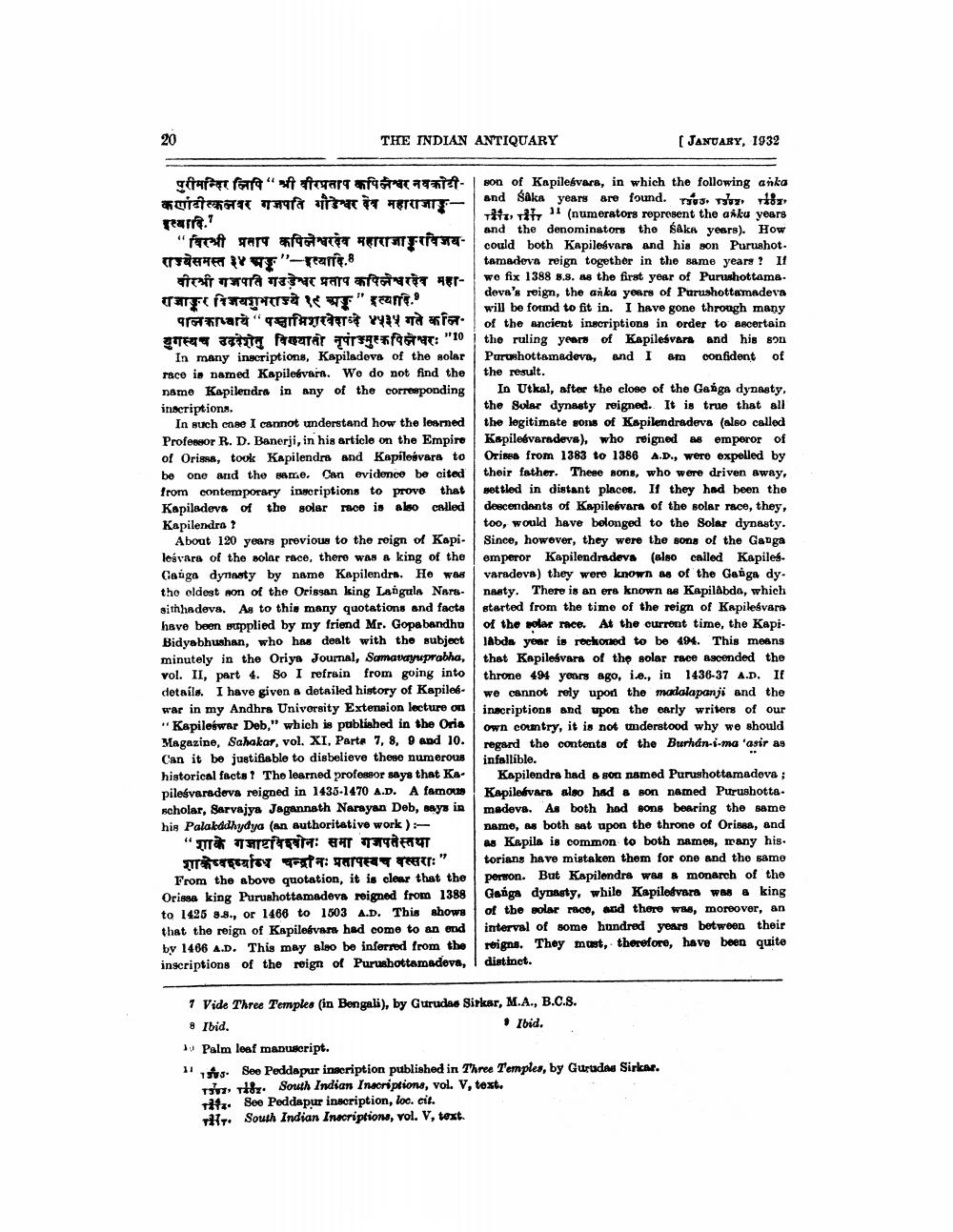________________
THE INDIAN ANTIQUARY
[ JANUARY, 1932
ftate for " f art 9 TRI- कर्णाटीकलवर गजपति गौडेश्वर देव महाराजाRare.
"विरश्री प्रताप कपिलेश्वरदेव महाराजापुरविजयT ARTY "- arf.8
वीरश्री गजपति गउड़ेश्वर प्रताप कपिलेश्वरदेव महाTat ry "reart.
पालकावाये "पचामिशरवेशाब्द ५३५ गते कलि. ETTET at foretar Trek : "10
In many inscriptions, Kapiladova of the solar race in named Kapilesvara. Wo do not find the namo Kapilendra in any of the corresponding inscriptions.
In such case I cannot understand how the learned Professor R. D. Banerji, in his article on the Empire of Orissa, took Kapilendra and Kapilesvars to be one and the same. Can evidence be cited from contemporary inscriptions to prove that Kapiladeva of the solar race is also called Kapilendra
About 120 years previous to the reign of Kapilesvara of the solar race, there was a king of the Cauga dynasty by name Kapilendra. He was the oldest aon of the Orissan king Laigula Narasithundeva. As to this many quotations and facts have been supplied by my friend Mr. Gopabandhu Bidyabhushan, who has dealt with the subject minutely in the Oriya Journal, Samavayuprabha, vol. II, part 4. So I refrain from going into details. I have given a detailed history of Kapileswar in my Andhra University Extension lecture on "Kapileswar Deb," which is published in the Oris Magazine, Sahakar, vol. XI, Parte 7, 8, 9 and 10. Can it be justifiable to disbelieve these numerous historical facts! The learned professor says that Ka. pilesvaradeva reigned in 1435-1470 A.D. A famorze scholar, Sarvajya Jagannath Narayan Deb, says in his Palakddhydya (an authoritative work)
"शाके गजाष्टविश्वोनः समा गजपतेस्तथा शाकेष्वाध चन्द्रानः प्रतापस्वच वत्सराः" From the above quotation, it is clear that the Orissa king Purushottamadeva reigned from 1388 to 1425 8.8., or 1466 to 1503 A.D. This shows that the reign of Kapile vara had come to an end by 1406 A.D. This may also be inferred from the inscriptions of the reign of Purushottamadeva,
son of Kapilesvara, in which the following anka and Sake years are found. Tous luz 87 Tiit THT 1 (numerators represent the aiku years and the denominators the Saka years). How could both Kapilesvara and his son Purushot. tamadeva reign together in the same years? If wo fix 1388 8.8. as the first year of Purushottama. deva's reign, the anka years of Purushottamadeva will be found to fit in. I have gone through many of the ancient inscriptions in order to ascertain the ruling years of Kapilesvara and his son Paroshottamadeve, and I am confident of the result.
In Utkal, after the close of the Ganga dynasty, the Solar dynasty reigned. It is true that all the legitimate sons of Kapilendradeva (also called Kapilesvaradeva), who reigned as emperor of Orissa from 1383 to 1386 A.D., were expelled by their father. These sons, who were driven away, Hettled in distant places. If they had been the descendants of Kapilesvara of the solar race, they, too, would have belonged to the Solar dynasty. Since, however, they were the sons of the Ganga emperor Kapilendradeva (also called Kapiles. varadeva) they were known as of the Ganga dy. nasty. There is an ers known as Kapilabda, which started from the time of the reign of Kapilesvara of the solar race. At the current time, the Kapilabda year is rockoned to be 494. This means that Kapilesvara of the solar race ascended the throne 494 years ago, io., in 1436-37 A.D. If we cannot rely upon the madalapanji and the inacriptions and upon the early writers of our own country, it is not tmderstood why we should regard the contents of the Burhán-i-ma 'asir as infallible.
Kapilendra had a son named Purushottamadova ; Kapilebvara also had & son named Purushotta. madeve. As both had sons bearing the same name, as both sat upon the throne of Orissa, and as Kapila is common to both names, many his. torians have mistaken them for one and the same person. But Kapilendra was a monarch of the Ganga dynasty, while Kapile vara was a king of the solar race, and there was, moreover, an interval of some hundred years between their reigns. They must, therefore, have been quite distinct.
1 Vide Three Temples (in Bengali), by Gurudas Sirkar, M.A., B.C.S. 8 Ibid.
Ibid. I Palm leaf manuscript. 11 . See Peddapur inscription published in Three Temples, by Gurdas Sirlar.
o 18. South Indian Inscriptions, vol. V, text. Tita. See Peddapur inscription, loc. cit. vily. South Indian Inscriptions, vol. V, text.




